History Of Abdul Hamid I
The Ottoman Sultan Who Paved the way for Modernization
Abdul Hamid I, the 27th Sultan of the Ottoman Empire, reigned from 1774 to 1789. Born on March 20, 1725, he was the son of Sultan Ahmad III and ascended to the throne after the death of his brother, Sultan Mustafa III. During his reign, Abdul Hamid I faced numerous challenges, including internal strife, external threats, and economic troubles. Despite these difficulties, he implemented various reforms aimed at modernizing the empire and strengthening its institutions.
Early Life and Accession
Abdul Hamid was born in the Topkapi palace, Istanbul, during the reign of his father, Sultan Ahmad III. As a member of the Ottoman dynasty, he received a traditional education, focusing on Islamic studies, literature, and martial arts. Despite being a potential heir to the throne, Abdul Hamid early life was marked by relative obscurity, as his brother Mustafa III was the preferred successor.
When Mustafa III died suddenly in 1774, Abdul Hamid ascended to the throne at the age of 49. His accession was met with a mixture of hope and skepticism, as the empire was facing significant internal and challenges.
Reforms and Achievements
Abdul Hamid I is often credited with initiating reforms that laid the groundwork for modernization in the Ottoman Empire. Some of his notable achievements include.
1 . Military Reforms.
Abdul Hamid recognized the need for a modernized military to counter external threats. He established new military units, such as the Nizam-I Cedid [New Order], Which were trained in European- style tactics and equipped with modern weaponry.
2 . Administrative Reforms.
The Sultan implemented administrative changes aimed at streamlining governance and increasing efficiency. He established new departments and councils, such as the Council of Useful Affairs, to address specific issues and advise the government.
3 . Economic Reforms.
Abdul Hamid I took steps to revitalize the Ottoman economy, which had bad been weakened by years of war and mismanagement. He encouraged trade, invested in infrastructure, and attempted to reforms the tax system.
4 . Diplomatic Efforts.
The Sultan sought to improve relation with European power, particularly Russia, and engaged in diplomatic efforts to secure peace treaties and alliances.

Challenges and Conflicts
Despite his efforts to reforms and modernize the empire, Abdul Hamid I faced numerous challenges and conflicts, including.
1 . War with Russia.
The Ottoman Empire had been at war with Russia since 1768, and Abdul Hamid I inherited this conflict, The war ended with the Treaty of Kucuk Kaynarca in 1774, which imposed significant territorial losses and indemnities on the Ottomans.
2 . Internal Rebellions.
The Sultan faced internal rebellions, particularly in the Balkans and Anatolia, which threatened the stability of the empire.
3 . Economic Troubles.
The Ottoman economy was plagued by inflation, corruption, and mismanagement, which hindered the Sultan efforts to modernize and strengthen the empire.
Legacy
Abdul Hamid I reign marked a significant turning point in Ottoman history. His reforms and efforts to modernize the empire laid the groundwork for future Sultans, particularly Selim III, who would continue his initiatives. Although the empire still faced significant challenges, Abdul Hamid I legacy as a reformer and modernizer has endured.
Impact on Ottoman Society
Abdul Hamid reforms had a profound impact on Ottoman society. The establishment of new military units and administrative reforms helped to modernize the empire’s institutions and improve governance. The Sultan efforts to revitalize the economy and promote trade also contributed to the growth of a more prosperous and diverse society.
Relations with European powers
Abdul Hamid I diplomatic efforts were aimed at improving relations with European powers, particularly Russia. The Treaty of Kucuk Kaynarca, although imposing significant territorial losses on the Ottomans, marked a significant shift in the empires relations with Europe. The Sultan’s efforts to engage in diplomatic relations with European power laid the groundwork for future Ottoman-European relations.
Conclusion
Abdul Hamid I reign was a complex and tumultuous period in Ottoman history. Despite the challenges he faced, the Sultan implemented significant reforms aimed at modernizing the empire and strengthening its institutions. His legacy as a reformer and modernizer continues to be studied and debated by historians, and his efforts to strengthen the Ottoman Empire remain an important chapter in the empire’s history.







